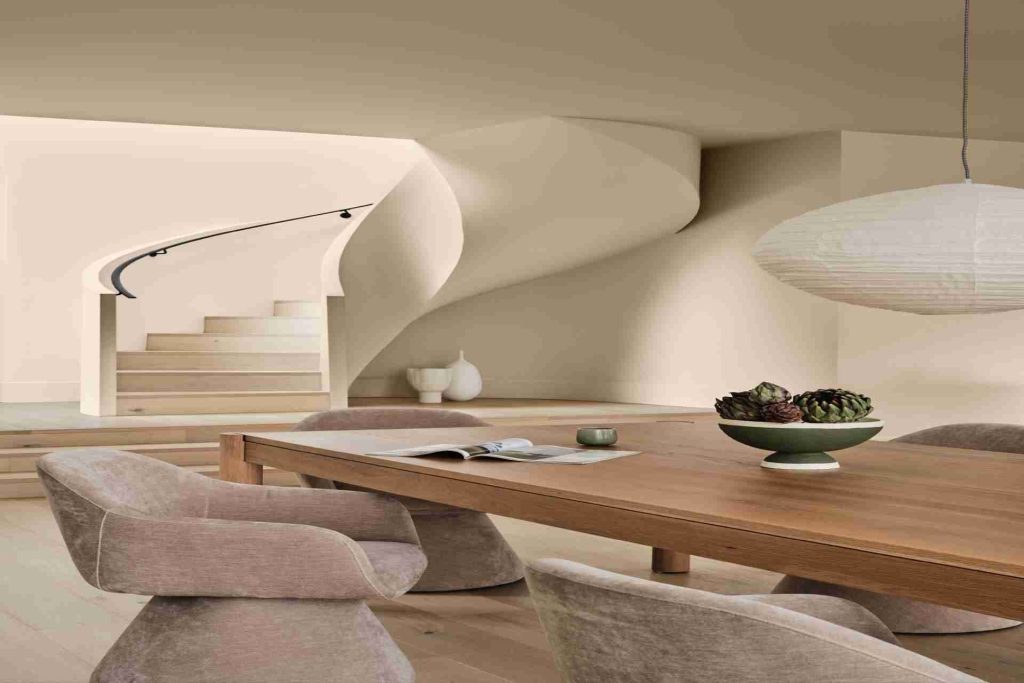
Bring Warmth Home with the Dulux ‘Still’ Palette This Winter
As the colder months roll in, many of us naturally start thinking about how to make our homes feel a little warmer, more inviting, and maybe just a bit refreshed. This year, Dulux’s Winter 2025 Colour Forecast is all about comfort, calm, and colours that make your home feel like a place to relax and recharge.
The forecast centres on a palette called Still, a soft and earthy mix of warm neutrals, gentle greens, moody blues, and a few surprises like warm greys and buttery yellows. According to Dulux colour specialist Davina Harper, the palette taps into the slower pace of life we tend to adopt during the colder months and the desire to create a space that feels settled and soothing.
How Dulux Chooses Its Colours
You might wonder how Dulux picks its colours each year, and no, it’s not just a guessing game. “We plan 12 months ahead,” Davina explains. “The annual Dulux Colour Forecast is based on year-round research into the latest global and local trends that are predicted to influence interior design and how we live.”
Their team pulls inspiration from global design events like Milan Design Week, works with colour forecasting groups like Colour Hive, and tracks catwalks, product launches, and trend reports. But they also look closer to home, keeping tabs on New Zealand fashion and home design, as well as Dulux’s own colour trend data.
“As well as looking at our own colour trend data, we look to local fashion brands and localised colour forecasting information to give us insights into which global colour trends will be most popular in Kiwi homes,” she says.

Standout Shades to Try This Winter
So, what are we painting our walls with this year? The Still palette is full of colours that feel soft, cosy and grounded. Think muted tones that are easy to live with but still bring a bit of character.
“The Still palette is predominantly neutral, warm and earthy – these colours help to soften a space, make us feel calmer and more grounded and have a beautiful ‘lived in’ look,” says Davina.
Standout colours include Dulux Clay Pipe, a warm, brown-based neutral that works beautifully on walls and ceilings, especially when paired with warm white Dulux Epsom. For something with a bit more depth, colours like Dulux Clay Court (a rich, reddish-brown), Dulux Te Aroha, and Dulux Shelly Beach (a soft, buttery yellow) bring extra warmth and interest to a room.
Davina’s personal favourite? Dulux Kaikorai Valley. “It’s a soft, mushroom colour with warm undertones of brown and lilac. It’s both cosy and timeless.”
One surprising trend in this year’s palette is the return of grey, but it’s not the cold, steely greys we saw years ago. “The shift towards grey aligns with consumer sentiment during periods of instability, where we are drawn to tones that represent stability and security,” says Davina.
These softer greys can add just the right amount of contrast to a warm-toned space, or they can work on their own to create a soothing, balanced room.
As the days get shorter and the sun disappears earlier, the way a room feels really starts to matter. That’s where thoughtful colour choices can help.
“Colder weather often makes us crave warmth, comfort and a cosy space,” Davina says. The Still palette is designed to help with that, with colours that feel nurturing and restful.

Where and How to Use These Colours in Your Home
But you don’t need to repaint the whole house to get the effect. Davina suggests focusing on smaller areas for maximum impact, like feature walls, doors, trims, or even furniture. “Paint one or two walls rather than a whole room, or paint smaller areas for maximum impact, such as the inside of shelving, a front door, furniture or small accessories,” she says.
One thing Davina stresses is that colours can look very different depending on where you live in New Zealand. Light changes everything, so what looks great in a Wellington home might feel completely different in Invercargill.
“My advice would be to always test colour in your space,” she says. Dulux offers A4 swatches and test pots so you can see how a colour looks at different times of the day, in both natural and artificial light.
To show how these colours work together in real homes, the Dulux team teamed up with stylist Bree Banfield to style a living room and bedroom using shades from the Still palette.
In the living room, they used Dulux Clay Court above the fireplace, a bold but earthy tone that adds depth without overwhelming the room. It’s paired with Dulux Kauri Cliffs Half on the surrounding walls and Dulux Epsom on the ceiling. Textures like boucle armchairs, wool throws, and timber finishes add extra warmth.
In the bedroom, they went for a moodier look using Dulux Urenui, a dark blue with grey undertones. The team layered soft bedding, linen, and wool throws to complete the look, proving that even deeper shades can feel light and relaxing when paired with the right textures.
If you’re looking to freshen up your space for autumn and winter, the Dulux Still palette offers a lot of flexibility. Whether you’re keen to go all-in with a room makeover or just want to try out a new accent wall or colour on a piece of furniture, the tones are versatile and easy to work with.
And if you’re not sure where to start? “Dulux Shelly Beach is a pale buttery yellow that acts as a soft highlight in otherwise neutral spaces. It’s perfect to use in a smaller space to create a sense of warmth – I’d love to use it in my study or laundry.”
This year’s colour forecast is about creating spaces that feel good to live in. Whether you’re drawn to rich neutrals, muted blues, or cosy mushroom tones, the Still palette has something for every home.
So if you’ve been thinking about giving your space a bit of a seasonal refresh, this might be just the inspiration you need to pick up a brush.
Photos provided by Dulux
Photographer: Lisa Cohen









